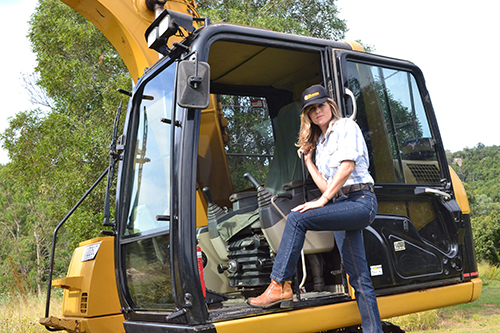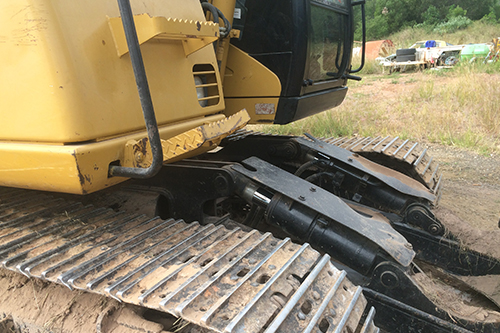In the first of our used equipment tests, RON HORNER reviews a 2008 Caterpillar 311cu excavator and points out what to look for when you’re buying one of these hard-working earthmovers.
For our first used machinery review we find ourselves in Boonah, a beautiful and picturesque area of the Scenic Rim in South East Queensland, and have secured a nice little 12-tonne Cat 311cu excavator owned by Floating Excavators.
The owner is Susan Hadgkiss and she tells me that the excavator is used most of the time in the mountainous, heavily treed and rocky areas of the Scenic Rim. The machine is the perfect size for the difficult work it undertakes, such as rural road construction, dam construction and cleaning, rural landscaping, general hire, rock work, and tree and foliage clearing.
The 311cu is also used as the secondary machine to assist the company’s Heking HK150SD floating excavator in its work in de-silting waterways, dams and sediment ponds. (You can read my review of the Heking here.)
This particular machine was purchased second-hand some three years ago, in its original condition and with 3,500 hours on the clock. It has a factory-fitted blade, a quick hitch and several attachments including an array of buckets, tilting trimming bucket, ripper, spreader bar and rock/log grab.
General appearance
The excavator is tidy enough for the work conditions it has faced since purchase — Susan says it has rarely worked in a stable, level and cleared environment.
The working conditions here in the mountains are horrendous at times, with the operator faced with lantana up to 5m in height, rocks larger than the machine is capable of handling safely, steep and dangerous conditions, trees and pretty thick scrub. It is inevitable that some damage to the machine will occur when working in these conditions.
As I walk around the Cat 311cu I can see tell-tale signs of its work history. Dents to the rear off side, scrub scratches along both sides of the machine, dents under the front tool box step caused by a rock, or several, being caught up in the tracks at some time, a damaged step on the tool box along with a torn off cab-access step on the track frame and dents underneath the undercarriage panels protecting the engine sump and pumps.
The safety guard rails have also had a hard time and one light is missing.
The machine now has a total of 5400 hours on the clock so we are going to have a look at any noticeable wear and tear, overall condition, performance, attachments and service and maintenance history. We’ll also give you some inside tips on how you can complete a quick assessment of a machine similar to this you may be contemplating purchasing.
The beauty of reviewing a ‘currently-in-use’ piece of equipment is that we can get in the operator’s seat and give it a good workout without running the risk of taking the paint off!
 |
|
Susan Hadgkiss from Floating Excavators.
|
In the cab
Well now I am in the Caterpillar’s cabin I must say that it is very comfortable and clean. The air-conditioner works very well and the dark tinted windows help enormously in keeping the heat from the Queensland sun to a minimum.
This excavator is very, very smooth and responsive to operate and the tracking of the machine is very good. No crabbing here.
The vision is very good and seating perfect with plenty of adjustment, with a radio as standard and an aftermarket two-way radio. The rear-vision mirrors have been dragged in to minimise damage from trees and scrub.
Watch the Cat 311cu video here
Performance
Fitted with two-speed travel controls, this little machine pushes very well for its size.
Because the blade is set so far in front of the tracks the operator can see all of the material being dragged into the front of the blade by the bucket. This makes it easy to pick up the material, almost like a 4 in 1 attachment. This is great for securing and picking up loose material, rocks and trees.
It also helps when you are pushing scrub or materials in bulk; it increases the volume of material you can push before running it back over the blade and under your tracks.
There is a little bit of movement in the bucket pins but the rest of it seems pretty tight for its age. The machine sits very solidly on the ground with excellent balance.
You can take comfort in knowing that having this blade on the ground when operating provides a more stable operating condition — more like a 20-tonner, really.
This machine comes with the factory- fitted longer dipper arm and you can feel the difference straight away … the reach is excellent, which you need when clearing the lantana out here.
The Cat has good climbing ability and is quite stable in some of the steep country I was able to access … and did I access some steep country!
 |
|
Damaged front step and hydraulic ram covers due to rock.
|
Inspection of wear parts
A quick inspection of the track gear proves to me that this machine has been in rocky conditions for a while. Wear rate on the drive sprockets is relatively high, although the rollers and track pins are still in quite reasonable conditions considering the amount of walking one machine with a blade will incur. The grouser plates are rounded off at the edges, suggesting a rocky environment has been encountered as well.
The blade shows signs of a tough working environment also as it has curvature and houses some dents, but the mould board bolts and cutting edge are in good order.
The bucket pins are worn and so is the quick hitch tongue — this is in need of repair in the not too distant future — but the dipper and boom pins are in excellent order.
A quick test on the slew motor bearings proves all is well and the hydraulic pump has no signs of adverse noise or vibration.
However, once I open the bonnet of the Cat 311cu I find that there is a small leak from the engine oil filler cap located on the top of the tappet cover, which will have to be addressed. All of the hoses and belts are in good order and the filters have been changed recently.
The key to having a reliable machine is to keep up with the maintenance and regular servicing.
The bottom line
This machine is still a little beauty with many years of productive life left in it.
Dismiss the small amounts of body damage caused by working in this type of environment and you have a relatively small sized machine with a great big heart and capable of producing the output of a 20-tonne machine if in the hands of a good operator.
This excavator can be used in smaller backyard jobs, detailed excavation, construction, landscaping , load tippers and pipelaying, then backfill and level off after the work has been completed.
The Cat 311cu is also capable of taking on bigger, more difficult jobs such as those the team at Floating Excavators are doing.
It is small enough to float from job to job easily enough, although you will need a low loader as it sits too high for a rigid truck.
Yes, undoubtedly the next 2000 hours will require some investment in repairs and maintenance, but by keeping up the daily servicing and maintenance this little fella will give plenty of honest hours of work for a few years to come.
Susan says the excavator has put in 5500 hours with minimal downtime and, relatively speaking, only minor hose and leaking ram repairs, ground engaging tools and run-of-the-mill stuff.
She says this Caterpillar has made its owners some decent income over its lifetime.
Don’t ever underestimate the purchase of a good-quality second-hand machine such as this little Cat. It has proven its reliability and resilience, affordability and profitability and, most of all, its versatility.
But do you know what I think is the best thing of all? This machine has got plenty of miles in it yet.
Click here to find Caterpillar excavators for sale.





